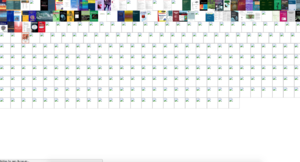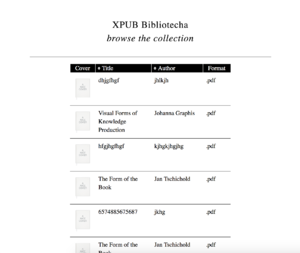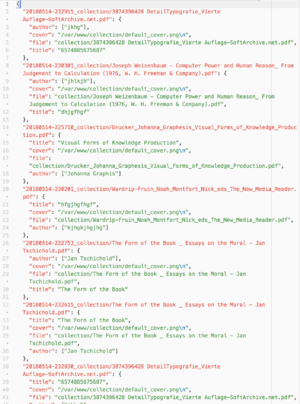User:Alexander Roidl/itl proposal: Difference between revisions
| Line 13: | Line 13: | ||
For the XPPL I am working on the infrastructure of the library and how to make this structures accessible in a useful but also in a playful way. | For the XPPL I am working on the infrastructure of the library and how to make this structures accessible in a useful but also in a playful way. | ||
The structure of the library is built around a database, that can be accessed from several points and in different ways. The infrastructure is built in such a way, that it can be modified easily. The platform itself will be hosted on a PI, that serves the library. The Library can be interfaced in programmatic as well as in graphical ways. The | The structure of the library is built around a database, that can be accessed from several points and in different ways. The infrastructure is built in such a way, that it can be modified easily. The platform itself will be hosted on a PI, that serves the library. The Library can be interfaced in programmatic as well as in graphical ways. The fundamental basis of the library is the database, but it shouldn’t hide within it self. The library should contain the books not only as downloadable pdf/ebook–book files, but also include the actually text in some form. To »convert[s] an image of a book page back into language – searchable, retrievable, scalable, and translatable. In the future motst designers will be creating reading experiences not book designs.« | ||
''how will it be made? (125)'' | ''how will it be made? (125)'' | ||
| Line 21: | Line 21: | ||
''why is it necessary? (125)'' | ''why is it necessary? (125)'' | ||
''Relation to project as whole (how does it interface with the rest of the PZI library project)'' | ''Relation to project as whole (how does it interface with the rest of the PZI library project)'' | ||
| Line 31: | Line 31: | ||
This projects connects to my previous interests in databases and how different programming approaches interface differently with the latter. Different ways of reading the database means different interfaces. I want to explore the structure of database driven projects | This projects connects to my previous interests in databases and how different programming approaches interface differently with the latter. Different ways of reading the database means different interfaces. I want to explore the structure of database driven projects | ||
References: | |||
Blauvelt, Andrew. (2010). From Books to Texts. In: M. Gerritzen, G. Lovink, M. Kampman, ed., I Read Where I Am: Exploring New Information Cultures, 1st ed.* Breda: Valiz/Graphic Design Museum. | |||
Revision as of 17:58, 27 May 2018
Project Proposal
https://pzwiki.wdka.nl/mediadesign/X-Lib
An interface for interfaces
The infrastructure of the library
what? (250)
For the XPPL I am working on the infrastructure of the library and how to make this structures accessible in a useful but also in a playful way. The structure of the library is built around a database, that can be accessed from several points and in different ways. The infrastructure is built in such a way, that it can be modified easily. The platform itself will be hosted on a PI, that serves the library. The Library can be interfaced in programmatic as well as in graphical ways. The fundamental basis of the library is the database, but it shouldn’t hide within it self. The library should contain the books not only as downloadable pdf/ebook–book files, but also include the actually text in some form. To »convert[s] an image of a book page back into language – searchable, retrievable, scalable, and translatable. In the future motst designers will be creating reading experiences not book designs.«
how will it be made? (125)
The library will provide a framework and API to be accessible. It is written in python and freely accessible and forkable for anybody. Therefore it integrates in the Experimental Publishing Course perfectly.
why is it necessary? (125)
Relation to project as whole (how does it interface with the rest of the PZI library project)
The infrastructure of the library provides all the interfaces with the necessary connection to the database. Therefore it connects all the interfaces to it in its database. The library you see is always a potential interface to it.
Relation to your self-directed research (how does it interface with previous work or abiding interests? what new interests are you following?)
This projects connects to my previous interests in databases and how different programming approaches interface differently with the latter. Different ways of reading the database means different interfaces. I want to explore the structure of database driven projects
References:
Blauvelt, Andrew. (2010). From Books to Texts. In: M. Gerritzen, G. Lovink, M. Kampman, ed., I Read Where I Am: Exploring New Information Cultures, 1st ed.* Breda: Valiz/Graphic Design Museum.
- Interface for Interfaces
- building the Infrastructure of the library
- Application programming interface
- different access points to the library
- interested in how the library opens up to the public
Ideas & Thoughts
required
(sorted by relevance)
- view books in library
- upload new books (might also work via scp)
- sort books (categorize, tag, edit metadata, description, ISBN)
- search (interface)
- users (access how and who?)
framework
- simple php / javascript + filestructure
- Mediawiki (modified?)
- Amusewiki: http://amusewiki.org/special/index
- Calibre
- Pi
library as physical object
- how can we put the PI into space?
- with display / connected to coffee machine?
- physical presence also as a reminder -> maintenance
ideas
- make pdfs available to everyone in local network
- make structure available to www (tunnel)
- distributed library (multiple persons have parts of the library)
PDF Reader / Editor in Web
- Possibilites to edit and view Pdfs in browser
- access PDFs in terms of search / preview
- View / Edit without »downloading«
- https://web.hypothes.is/ for web annotation
Decisions
Using a pi with webinterface Catalog is available online, while files are stored offline and only accessible via the local network. python dictonary -> use shelve python -> API with python



